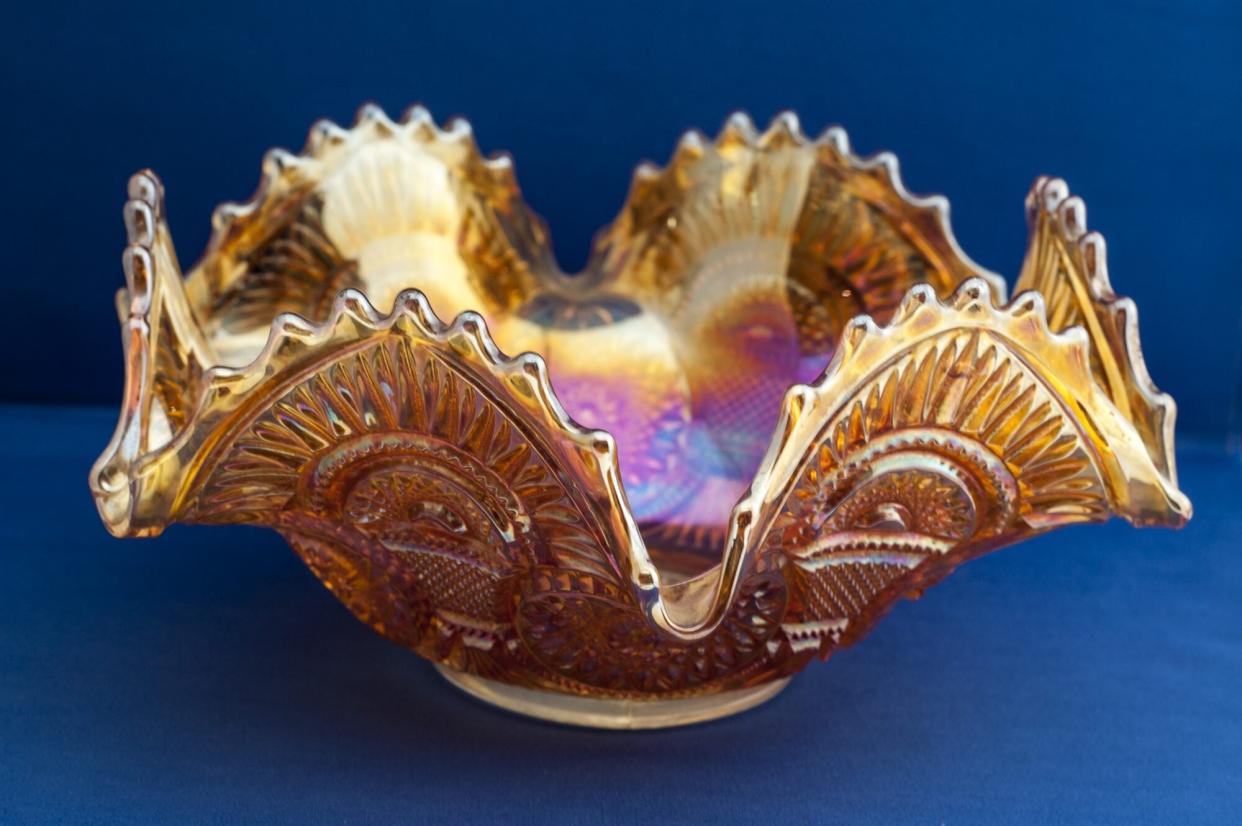All About Carnival Glass: What Is It and How Do You Collect It?

Education Images/Universal Images Group via Getty Images
Luminescent and solid, mysteriously shimmering with elusive colors on crisply molded shapes, carnival glass has a dual personality. These pressed-glass objects—bowls, plates, compotes, tumblers, and countless other items—were originally made to be affordable, functional, and attractive. Replete with grapes, peacocks, and other symbols of abundance and luxury, the designs looked old-fashioned even when they were new, nearly a century ago. Iridescent sprays create rainbow reflections that seem to foreshadow the improvisational action painting of the 1940s and '50s, as well as the psychedelia of the '60s. If Jackson Pollock and Peter Max had collaborated with your great-grandmother, the result might have been early carnival glass.
Interested to learn more? Here's what to know about identifying and valuing this vintage American glassware from those that collect it.
Related: Our Editors' Favorite Items to Start Collecting
The History of Carnival Glass
Carnival glass is a kind of iridescent glass coated to refract light, which gives the glass a rainbow appearance similar to what you see on an oil slick or the surface of a bubble. The first examples were introduced in 1907 by Fenton Art Glass, a West Virginia glassworks still in business; other American manufacturers soon developed rival lines to satisfy the enormous demand for these decorative wares. What modern collectors regard as carnival's "classic" period ended around 1925, with the increasing mechanization of glass production and changing tastes, which favored simpler shapes and less showy surfaces. Nevertheless, some carnival glass continued to be made through the thirties, not only in the United States but also in Argentina, Australia, Czechoslovakia, England, Sweden, and other countries that had followed America's lead.
Because the name carnival glass, like Depression glass, was coined decades after the glass was made, terminology can get blurry. The glass we now know as carnival was originally marketed under names like Iridescent, Pompeian, and Iridill as an inexpensive alternative to Tiffany Studios' costly handblown favrile and opalescent art glass. This "poor man's Tiffany" (to use one of carnival's many nicknames) was pressed in molds, though it still required plenty of handwork. Craftsmen had to crimp hot glass to shape scalloped or fluted rims, and spray a liquid metallic salt solution onto individual items. Specific color effects depended on the temperature of the glass and the number of layers sprayed on. The slightest variation in conditions produced a different result, so each piece is unique. Manufacturers viewed spraying as a craft. "It took an experienced sprayer to develop the right colors," says Howard Seufer, a longtime head of quality control for Fenton, which has been making new versions of carnival glass since the '60s.
The name carnival came into use in the '50s or '60s, when pioneering collectors of early pieces believed the glass had fallen so far out of fashion that it had been given out as cheap prizes on the midway. This may be a myth, but carnival seems appropriate for a glass that's colorful and fun. The golden-tone glass is the orange that collectors call marigold. Carnival glass usually takes its main color from the tinted glass to which the glaze is applied. To create marigold, however, clear glass is sprayed with iron chloride. Carnival-glass expert Glen Thistlewood, author of books on the subject and writer of an e-mail newsletter for the Woodsland World Wide Carnival Glass Association, speculates that marigold may have been a best-seller in the early twentieth century because indoor light levels were low and the furniture was dark. "Put marigold on a mission oak table, light one small lamp," she says, "and the glass just glows."
Determining Value
Pieces can command serious prices, however—in the thousands of dollars for classics in rare colors and patterns. The increased availability of foreign carnival glass has complicated a category that was once considered Americana, and lookalikes manufactured since the fifties can be mistaken for classics. Vintage carnival glass is seldom marked, so determining the origin of a piece or even distinguishing it from new glass can be quite difficult. Some of the new pieces sold today are reproductions made in re-created molds. Others are reissued pieces formed in the original molds.
The best way to learn to distinguish the real from the fake is to familiarize yourself with both. Visit glass shows and antiques shops that sell carnival glass. In the meantime, here are some things to look for: New pieces sometimes have an oily feel to them. A coating applied to the mold so pieces can easily be removed causes such a residue. If the pattern is indistinct, an old mold or poor re-creation may have been used. Also, check for wear on the bottom of the piece: old pieces will generally show scratches and have a dull base. If a piece is bigger than what your reference books describe, it may have been made from a re-created mold.
Fancy patterns marked carnival's heyday (from 1907 to circa 1925); a Fenton butterfly tumbler would now fetch $50 to $125. Thirties streamlining appears in a tall glass, $12 to $16. Some '50s pieces—like a Peach Glow Fire-Kingcup, which fetch $12 to $16—evoke bygone opulence. Others, such as a juice glass, $3 to $5, have a modern aura. Overzealous washing can wear off glaze, reducing value, so handle gently and check for wear when buying. If in doubt, take the piece to a knowledgeable, reputable antiques dealer.
Thanks to its popularity back when carnival glass was a novelty, marigold remains the most plentiful hue of all, and it is generally affordable. You can understand why Thistlewood says that "just about every collector starts with marigold." That warm glow has lost none of its original appeal.

